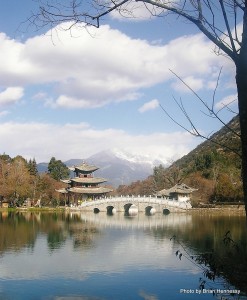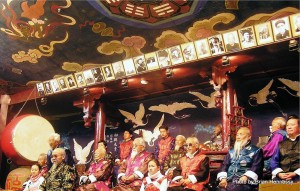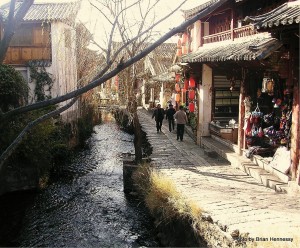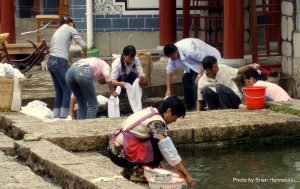Lijiang. Yunnan.
Brian Hennessy. An Australian in China. 2007, 2008, 2009
“Where in all the world can you find scenery comparable to that which awaits the explorer and photographer in north-western Yunnan province?” Joseph Rock, explorer and botanist, 1928.
“The region from Lijiang to the Tibetan border is surely one of the most wonderful in China.” Lonely Planet, 2002.
Lijiang. Yunnan Province
______________________________________________________________
Lijiang sits on a high plain surrounded by magnificent mountains, the highest of which is Yulong Xueshan (Jade Dragon Snow Mountain). At 5596m this monolith dominates the northern end of the plain and provides a southern bulwark to the surging Jinshajiang – the upstream name for the Yangtze River – as it rushes downhill through one of the deepest gorges in the world: Tiger Leaping Gorge.
Snuggling comfortably around the south-eastern base of Elephant Hill (a minor player on a field of giants), Lijiang enjoys a well-earned reputation for a good climate, a vibrant Naxi minority culture, and an authentic old-town which is insulated from modern tourist infrastructure by an otherwise unremarkable brick and stucco wall.
This is not to say that the more modern part of Lijiang is uninteresting place. Not true. If you look, you can still find many surprises in old alleys and markets hiding behind the new facades of supermarkets and up-market department stores lining the main streets. Exotic places where you can admire the skill of a tinsmith as he transforms a sheet of metal into useful utensils, be confronted by large slabs of meat hanging from a restaurant wall, or be ripped-off by one of the many smiling and oh-so-friendly traders who await your arrival in their territory. Spiders who welcome you into their web. Beware! These guys are not sole-traders, they are a community of thieves!
It is much better to buy your souvenirs in the ethnic shopfronts of the old town. Fascinating traditional structures leaning over cobblestoned alleys in pleasing, chaotic disorder. Narrow thoroughfares ignoring the rules of geometry as they follow the random course of ancient freshwater streams flowing through the old town.
The ancients were a wise old lot. Towards the high end of town, towards the snow-fed subterranean source of this pure water, you can find evidence of their forethought. Three adjacent stone-bordered small pools. Fresh water entering the first, overflowing to the second, and then draining from the third to continue its meander through town and on to the plain beyond.
The first pool is for drinking water. The second is for washing utensils and vegetables etc., and the third is for bathing, washing clothes, and so on. Smart old greybeards, they were. Way ahead of European civilisation at that time in terms of public health.
You can wander around this old town for days. It’s a friendly place. And don’t be frightened to say hello to the locals. There is no law that says you have to buy what they are selling, and they won’t follow you down the alley shoving overpriced rubbish in your face.
You can move on without harassment to the next store to see a lady operating a loom, a man carving wooden or stone artifacts, or a jeweller creating something special in silver. Perhaps you might be interested in buying some ethnic or modern clothing. Or purchasing hand-crafted accessories in leather, metal, or some other material.
Food? You can sample Chinese, Japanese, Korean, or Western fare in many small restaurants bordering the stone channelled streams which add so much charm to this old town; or go looking for different flavours in the exotic Naxi or Tibetan establishments. See a small pig roasted on a spit, or barbecued before your eyes as you drink the local beverages and are entertained by Naxi or Tibetan dancers.
What can you do after dinner? Many tourists like to browse around the old town, taking in the colourful lights, scenery, and atmosphere. Some prefer to take a closer look at local culture by visiting the old Naxi Music Academy for an evening of authentic Taoist music from the Han, Song, and Tang dynasties. It’s worth going just to see the octogenarian grey-beards in the orchestra. They are pretty good. Other folk prefer a more modern mix of old song and new dance performances by one of its competitors just across the lane.
If you are not a culture vulture, then head for one of the many noisy bars on Jiuba Street for a few too many glasses of overpriced alcohol and a dose of eardrum bursting music and dance. This street rocks! Although most of the revellers are Chinese tourists, you might also get the chance to mix your drinks and your cultures by hanging out with some friendly Naxi, Mosuo, or Tibetan folk.
And in the morning, nurse your hangover in the sun with a cup of Yunnan coffee as you watch the older Naxi ladies in traditional dress dance in the open square near the northern entry to the old town. Why not join them? You will be welcomed, and it will be good for you and your hangover.
A word or two about traditional Naxi architecture. Stone, wood, and mud-brick dwellings, built around an internal courtyard. Although attractive to the eye, these structures have a functional bias to their design. They can cope with earthquakes:-
In 1996, an earthquake measuring over 7 on the Richter scale rocked the Lijiang area. Although the more modern buildings were levelled, those in the old town coped much better with this disaster, prompting the authorities to take note of traditional Naxi methods of construction in an earthquake-prone environment. New building codes reflect a willingness to learn from experience. You’ll be safe.
Lijiang, a wonderful place to stay for awhile.
For the more adventurous, the area surrounding Lijiang offers something special. For example; why not hire a horse + guide and ride slowly up to the snowline on Yulong Xueshan? The view of the valley below is breathtaking. Or do it the easy way, and catch a cablecar to 4500m and admire the glacier (with a full head of oxygen…sold to you by a trader, of course). This way you will enjoy and remember what you experienced! Another option might be to hire a bicycle and visit one of the nearby Naxi villages.
The trip to Tiger Leaping Gorge is a ‘must see’ experience for anyone who visits Lijiang and who has two legs in good working order. And for those armchair anthropologists who understand how rivers can cradle a new civilisation, a visit to the first bend of the Jinshajiang at Shigu is mandatory. A place to ponder the cultural consequences had this mighty river not reversed its course and flowed through the heart of China to the east coast, but instead had continued its way south through south-east Asia…following the same path as the other two mighty rivers of this region, the Lancangjiang (Mekong River) and the Nujiang (Salween).
There is much more to describe and see in the Lijiang area, such as: the scenic and peaceful Black Dragon Pool, famous Tibetan monasteries, places of Dongba (Naxi) culture, and so on. However, why not include a visit to Lijiang and North-west Yunnan on your next holiday and see “the most wonderful region in China” for yourself? I guarantee you will not be disappointed.





